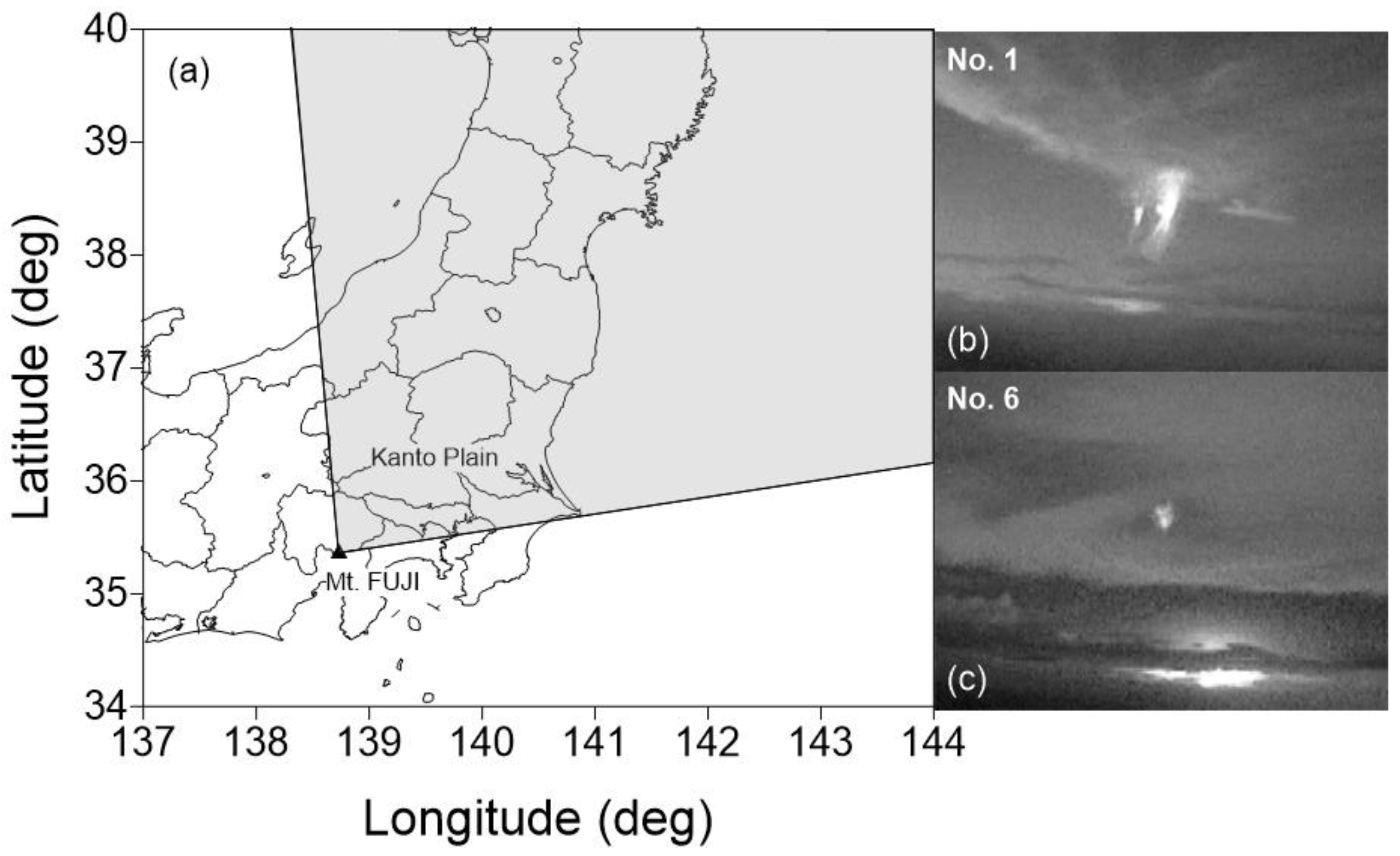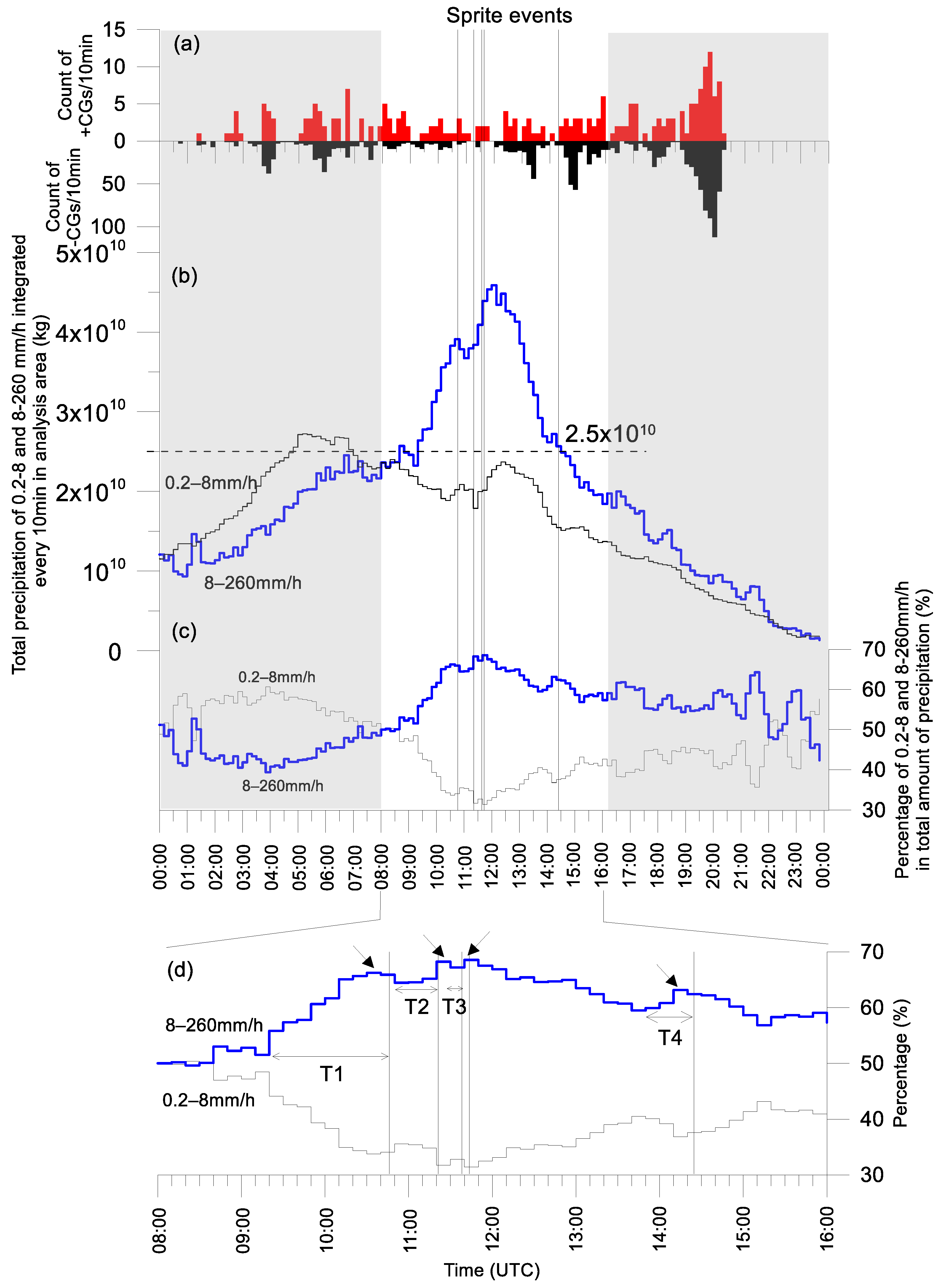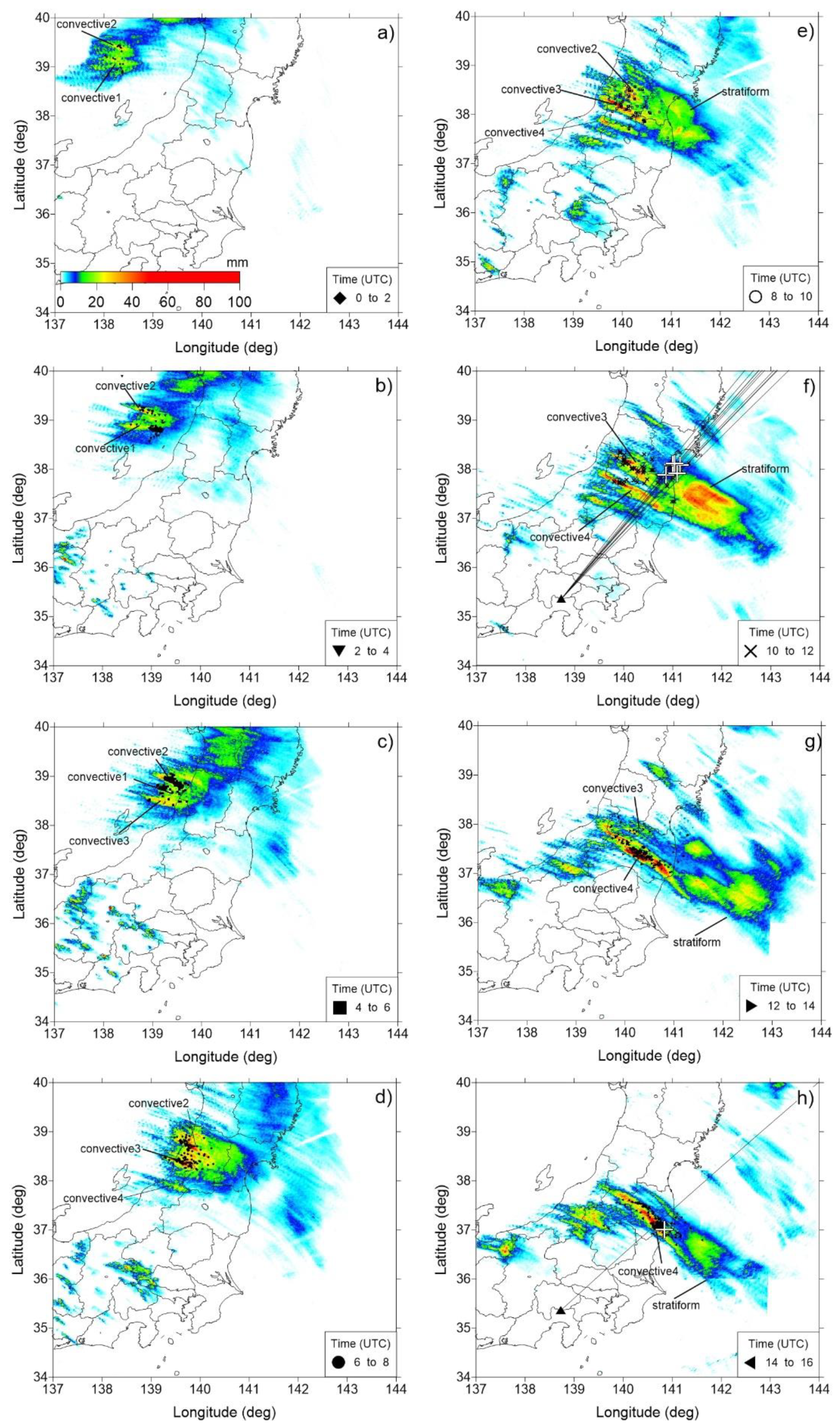Temporal and Spatial Evolution of Precipitation under the Summer Sprite Parent Mesoscale Convective Systems in Japan
Abstract
:1. Introduction
2. Observations and Data
3. Analysis
4. Results and Discussion
5. Conclusions
Author Contributions
Funding
Institutional Review Board Statement
Informed Consent Statement
Data Availability Statement
Acknowledgments
Conflicts of Interest
References
- Franz, R.C.; Nemzek, R.J.; Winckler, J.R. Television image of a large upward electrical discharge above a thunderstorm system. Science 1990, 249, 48–51. [Google Scholar] [CrossRef] [PubMed]
- Neubert, T.; Allin, T.H.; Stenbaek-Nielsen, H.; Blanc, E. Sprites over Europe. Geophys. Res. Lett. 2001, 28, 3585–3588. [Google Scholar] [CrossRef]
- Pinto, O.; Saba, M.M.F.; Pinto, I.R.C.A.; Tavares, F.S.S.; Naccarato, K.P.; Solorzano, N.N.; Taylor, M.J.; Pautet, P.D.; Holzworth, R.H. Thunderstorm and lightning characteristics associated with sprites in Brazil. Geophys. Res. Lett. 2004, 31, L13103. [Google Scholar] [CrossRef] [Green Version]
- Su, H.-T.; Hsu, R.-R.; Chen, A.B.-C.; Lee, Y.-J.; Lee, L.-C. Observation of sprites over the Asian continent and over oceans around Taiwan. Geophys. Res. Lett. 2002, 29, 1044. [Google Scholar] [CrossRef]
- Suzuki, T.; Hayakawa, M.; Hobara, Y.; Kusunoki, K. First detection of summer blue jets and starters over Northern Kanto area of Japan: Lightning activity. J. Geophys. Res. 2012, 117, A07307. [Google Scholar] [CrossRef] [Green Version]
- Williams, E.R.; Lyons, W.A.; Hobara, Y.; Mushtak, V.C.; Asencio, N.; Boldi, R.; Bór, J.; Cummer, S.A.; Greenberg, E.; Hayakawa, M.; et al. Ground-based detection of sprites and their parent lightning flashes over Africa during the 2006 AMMA campaign. Q. J. R. Meteorol. Soc. 2010, 136, 257–271. [Google Scholar] [CrossRef]
- Adachi, T.; Fukunishi, H.; Takahashi, Y.; Sato, M.; Ohkubo, A.; Yamamoto, K. Characteristics of thunderstorm systems producing winter sprites in Japan. J. Geophys. Res. 2005, 110, D11203. [Google Scholar] [CrossRef] [Green Version]
- Fukunishi, H.; Takahashi, Y.; Uchida, A.; Sera, M.; Adachi, K.; Miyasato, R. Occurrence of sprites and elves above the Sea of Japan near Hokuriku in winter. Eos Trans. AGU 1999, 80, F217. [Google Scholar]
- Ganot, M.; Yair, Y.; Price, C.; Ziv, B.; Sherez, Y.; Greenberg, E.; Devir, A.; Yaniv, R. First detection of transient luminous events associated with winter thunderstorms in the eastern Mediterranean. Geophys. Res. Lett. 2007, 34, L12801. [Google Scholar] [CrossRef]
- Hayakawa, M.; Nakamura, T.; Hobara, Y.; Williams, E. Observation of sprites over the Sea of Japan and conditions for lightning-induced sprites in winter. J. Geophys. Res. 2004, 109, A01312. [Google Scholar] [CrossRef]
- Soula, S.; van der Velde, O.; Palmiéri, J.; Chanrion, O.; Neubert, T.; Montanyà, J.; Gangneron, F.; Meyerfeld, Y.; Lefeuvre, F.; Lointier, G. Characteristics and conditions of production of transient luminous events observed over a maritime storm. J. Geophys. Res. 2010, 115, D16118. [Google Scholar] [CrossRef]
- Suzuki, T.; Hayakawa, M.; Matsudo, Y.; Michimoto, K. How do winter thundercloud systems generate sprite-inducing lightning in the Hokuriku area of Japan? Geophys. Res. Lett. 2006, 33, L10806. [Google Scholar] [CrossRef]
- Takahashi, Y.; Miyasato, R.; Adachi, T.; Adachi, K.; Sera, M.; Uchida, A.; Fukunishi, H. Activities of sprites and elves in the winter season, Japan. J. Atmos. Sol. Terr. Phys. 2003, 65, 551–560. [Google Scholar] [CrossRef]
- Bór, J. Optically perceptible characteristics of sprites observed in Central Europe in 2007–2009. J. Atmos. Sol. Terr. Phys. 2013, 92, 151–177. [Google Scholar] [CrossRef] [Green Version]
- Sentman, D.D.; Wescott, E.M. Observations of upper atmospheric optical flashes recorded from an aircraft. Geophys. Res. Lett. 1993, 20, 2857–2860. [Google Scholar] [CrossRef]
- Boccippio, D.J.; Williams, E.R.; Heckman, S.J.; Lyons, W.A.; Baker, I.T.; Boldi, R. Sprites, ELF transients and positive ground strokes. Science 1995, 269, 1088–1091. [Google Scholar] [CrossRef]
- Sentman, D.D.; Wescott, E.M. Red sprites and blue jets: High-altitude optical emissions linked to lightning. Eos Trans. AGU 1996, 77, 1–5. [Google Scholar] [CrossRef]
- Lyons, W.A. Sprite observations above the U.S. High Plains in relation to their parent thunderstorm systems. J. Geophys. Res. 1996, 101, 29641–29652. [Google Scholar] [CrossRef]
- São Sabbas, F.T.; Sentman, D.D.; Wescott, E.M.; Pinto, O.; Mendes, O.; Taylor, M.J. Statistical analysis of space-time relationships between sprites and lightning. J. Atmos. Sol. Terr. Phys. 2003, 65, 525–535. [Google Scholar] [CrossRef]
- Lyons, W.A.; Stanley, M.; Meyer, J.D.; Nelson, T.E.; Rutledge, S.A.; Lang, T.J.; Cummer, S.A. The meteorological and electrical structure of TLE-producing convective storms. In Lightning: Principles, Instruments and Applications; Betz, H.D., Schumann, U., Laroche, P., Eds.; Springer: New York, NY, USA, 2009; pp. 387–415. [Google Scholar] [CrossRef]
- Stanley, M.A. Sprites and Their Parent Discharges. Ph.D. Thesis, New Mexico Institute of Mining and Technology, University Microfilms, Ann Arbor, MI, USA, 2000; 164p. [Google Scholar]
- Suzuki, T.; Matsudo, Y.; Asano, T.; Hayakawa, M.; Michimoto, K. Meteorological and electrical aspects of several winter thunderstorms with sprites in the Hokuriku area of Japan. J. Geophys. Res. 2011, 116, D06205. [Google Scholar] [CrossRef]
- Lang, T.J.; Lyons, W.A.; Rutledge, S.A.; Meyer, J.D.; MacGorman, D.R.; Cummer, S.A. Transient luminous events above two mesoscale convective systems: Storm structure and evolution. J. Geophys. Res. 2010, 115, A00E22. [Google Scholar] [CrossRef] [Green Version]
- Suzuki, T.; Kamogawa, M.; Fujiwara, H.; Hayashi, S. MCS stratiform and convective regions associated with sprites observed from Mt. Fuji. Atmosphere 2022, 13, 1460. [Google Scholar] [CrossRef]
- Carey, L.D.; Murphy, M.J.; McCormick, T.L.; Demetriades, N.W.S. Lightning location relative to storm structure in a leading-line, trailing-stratiform mesoscale convective system. J. Geophys. Res. 2005, 110, D03105. [Google Scholar] [CrossRef]
- Lu, G.; Cummer, S.A.; Li, J.; Zigoneanu, L.; Lyons, W.A.; Stanley, M.A.; Rison, W.; Krehbiel, P.R.; Edens, H.E.; Thomas, R.J.; et al. Coordinated observations of sprites and in-cloud lightning flash structure. J. Geophys. Res. 2013, 118, 6607–6632. [Google Scholar] [CrossRef] [Green Version]
- Ishii, K.; Hayashi, S.; Fujibe, F. Statistical analysis of temporal and spatial distributions of cloud-to-ground lightning in Japan from 2002 to 2008. J. Atmos. Electr. 2014, 34, 79–86. [Google Scholar] [CrossRef] [Green Version]
- Houze, R.A., Jr. Structure and Dynamics of a Tropical Squall-Line System. Mon. Weather Rev. 1977, 105, 1540–1567. [Google Scholar] [CrossRef]
- Rutledge, S.A.; MacGorman, D.R. Cloud-to-ground lightning activity in the 10–11 June 1985 mesoscale convective system observed during the Oklahoma-Kansas PRE-STORM Project. Mon. Weather Rev. 1988, 116, 1393–1408. [Google Scholar] [CrossRef]
- Hayakawa, M.; Suzuki, T.; Nakamura, T.; Michimoto, K.; Iudin, D. Fractal analysis of radar images of Japanese winter thunderclouds inducing sprites and its comparison with their corresponding life cycle. J. Atmos. Elector. 2007, 27, 113–121. [Google Scholar] [CrossRef]
- Houze, R.A., Jr.; Smull, B.F.; Dodge, P. Mesoscale Organization of Springtime Rainstorms in Oklahoma. Mon. Weather Rev. 1990, 118, 613–654. [Google Scholar] [CrossRef]
- Parker, M.D.; Johnson, R.H. Organizational Modes of Midlatitude Mesoscale Convective Systems. Mon. Weather Rev. 2000, 128, 3413–3436. [Google Scholar] [CrossRef]
- Parker, M.D.; Rutledge, S.A.; Johnson, R.H. Cloud-to-Ground Lightning in Linear Mesoscale Convective Systems. Mon. Weather Rev. 2001, 129, 1232–1242. [Google Scholar] [CrossRef]
- Lyons, W.A.; Nelson, T.E.; Williams, E.R.; Cummer, S.A.; Stanley, M.A. Characteristics of Sprite-Producing Positive Cloud-to-Ground Lightning during the 19 July 2000 STEPS Mesoscale Convective Systems. Mon. Weather Rev. 2003, 131, 2417–2427. [Google Scholar] [CrossRef]
- Soula, S.; Defer, E.; Füllekrug, M.; van der Velde, O.; Montanya, J.; Bousquet, O.; Mlynarczyk, J.; Coquillat, S.; Pinty, J.-P.; Rison, W.; et al. Time and space correlation between sprites and their parent lightning flashes for a thunderstorm observed during the HyMeX campaign. J. Geophys. Res. 2015, 120, 11552–11574. [Google Scholar] [CrossRef] [Green Version]
- MacGorman, D.R.; Rust, W.D. The Electrical Nature of Storms; Oxford University Press: New York, NY, USA, 1998; pp. 281–282. [Google Scholar]
- Stolzenburg, M.; Rust, W.D.; Smull, B.F.; Marshall, T.C. Electrical structure in thunderstorm convective regions: 1. Mesoscale convective systems. J. Geophys. Res. 1998, 103, 14059–14078. [Google Scholar] [CrossRef]
- Azambuja, R. Thunderstorms Producing Sprites in South America. Ph.D. Thesis, Instituto Nacional de Pesquisas Espaciais, Sao Jose dos Campos, Brazil, 2013. [Google Scholar]
- Williams, E. Lightning Activity in Winter Storms: A Meteorological and Cloud Microphysical Perspective. IEEJ Trans. Power Energy 2018, 138, 364–373. [Google Scholar] [CrossRef]




Publisher’s Note: MDPI stays neutral with regard to jurisdictional claims in published maps and institutional affiliations. |
© 2022 by the authors. Licensee MDPI, Basel, Switzerland. This article is an open access article distributed under the terms and conditions of the Creative Commons Attribution (CC BY) license (https://creativecommons.org/licenses/by/4.0/).
Share and Cite
Suzuki, T.; Kamogawa, M.; Fujiwara, H.; Hayashi, S. Temporal and Spatial Evolution of Precipitation under the Summer Sprite Parent Mesoscale Convective Systems in Japan. Atmosphere 2022, 13, 1661. https://doi.org/10.3390/atmos13101661
Suzuki T, Kamogawa M, Fujiwara H, Hayashi S. Temporal and Spatial Evolution of Precipitation under the Summer Sprite Parent Mesoscale Convective Systems in Japan. Atmosphere. 2022; 13(10):1661. https://doi.org/10.3390/atmos13101661
Chicago/Turabian StyleSuzuki, Tomoyuki, Masashi Kamogawa, Hironobu Fujiwara, and Syugo Hayashi. 2022. "Temporal and Spatial Evolution of Precipitation under the Summer Sprite Parent Mesoscale Convective Systems in Japan" Atmosphere 13, no. 10: 1661. https://doi.org/10.3390/atmos13101661





